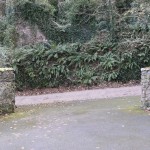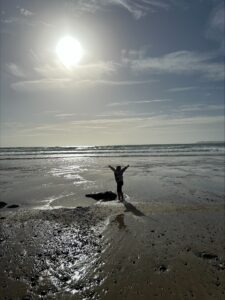Cap Stones for The Anchorage Gate Posts
One summer when our oldest son Peter was 12 years old, we took one of his school friends (Matthew) with us to Pembrokeshire for our annual summer holiday. Our group then consisted of my wife, myself, the two boys, a daughter about 8 years old and our youngest son was about 2 years and travelled in a push chair. With two 12 year old boys I had to think of interesting things to do. At the same time I was slowly pushing the project at Sandy Haven ahead. We had already built two pairs of gateposts of our garden sandstone blocks and put farm gates on them. I thought some interesting cap stones would go nicely on the top of the gateposts. Our favourite beach was always Lindsway and one day there I had a good search about and located four fine rounded boulders of red Devonian conglomerate that would make ideal capstones. I stacked them at the top of the beach and planned to go there with the two boys to collect them by boat. Unfortunately the next day a storm blew up and we postponed it for a few days.
Finally the weather looked good and we loaded the car with beach things and picnic and set off to Sandy Haven where the boats were stored in a garage (the house was not yet built). The plan was for my wife and the two youngest children to walk along the coast path (the youngest in a pushchair) to Lindsway beach. The two boys and I would sail our Mirror dinghy at high tide to Lindsway, spend the day as a family on the beach and then at high tide again in the evening load the cap stones and sail back to Sandy Haven where we would meet up with the walking party. The timing was so we would be sailing with the tide each way and not against it. We had a Mirror dinghy but no motor (because I enjoy the skill with small boats of harnessing the wind and tide, not just letting a noisy machine push one along) and we towed an old fibre glass Sunfish hull to carry the rocks. The idea was that if the rocks caused the boat to sink, we would cut the tow rope and sail home without them. It all sounded too good to be true but the boys were most enthusiastic and I wanted some cap stones.
All started well. My wife set off with the young children and pushchair along the coast path. The boys and I launched the dinghy and Sunfish hull and carried the picnic with us. We had a good sail as far as Lindsway Bay on the outgoing tide, but on arrival we found a big surf running. However we gritted our teeth and sailed in but both boats filled with surf before we landed on the beach. So we bailed out the boats and pulled them up on the beach as the tide was going out. We were met by my wife and the young children. When I looked around I was astonished to find the beach had been greatly changed by the storm. My pile of capstones had vanished and all the sand had disappeared from the beach – something we had never seen before or since. There was a hard clay bottom to the beach that was embedded with all sorts of rusty metal objects never seen before. So I set off to find some more capstones. Unfortunately, just at this time Nature intervened. The sun disappeared as grey clouds appeared overhead, so I hurried and managed to collect an inferior set of stones to those lost to the storm. These inferior stones are the ones that we have on the gateposts today. Then misery of misery, even before we had any picnic, it began to rain. My wife was most unimpressed and decided we must go back because of the small children. This was a problem for me as the tide was now about half out and we would have to sail back against the tide and when we got back to Sandy Haven the water would be too low to get the boats back to the top of the beach. However it was raining so we decided it would be better to return as my wife was not pleased with combination of rain and small children. Happily she stayed to watch our departure as I told her I was not sure if I could get the two boats and the stones back through the big surf.
Happily as a geologist living and working in the Caribbean some years earlier, I had greatly enjoyed the sea with both SCUBA diving and spear fishing. While working over many years on the Lesser Antillean islands with a fellow geologist, we had developed a technique for sampling the high cliffs on the Atlantic or windward side of the Caribbean islands. We put a coil of rope, notebooks, marker pens, sample bags and a sledge hammer into a large PVC salt pork drum and screwed the lid on tight and threw it into the surf from a hired fishing canoe. I would then swim ashore with facemask and flippers through the surf, gather up the drum, collect the rock samples required and put them and the sledge hammer back in the drum. I would tie a long line to the drum and then swim out beyond the surf and with flippers pull the drum slowly out to me through the surf. My friend would soon have the fishing canoe alongside and we motored back to the harbour with our samples. We planned to use a similar technique to get the gate post stones offshore. So my son and I got into the Mirror dinghy and by careful timing, with the sails up, managed to sail through the surf. We towed a long line attached to the Sunfish hull with the stones. Matthew’s job was to push out the boat and then jump aboard as we towed him offshore. It was slow but we managed to get the Sunfish and rocks through the surf. Unfortunately at the last moment a large wave broke over the Sunfish and washed Matthew overboard and he was washed back to the beach where my wife recovered him cold and wet in the rain. There was no possibility of our going back for him as it had been difficult to get through the surf. So my wife was left with the difficult task in the rain of taking a pram, two children, a picnic and a wet 12 year old boy who had no shoes or clothes with him, back up the steep steps and along the coast path to The Anchorage. Happily she succeeded.
Meanwhile my son and I started sailing back to Sandy Haven towing the Sunfish in cold rainy weather. Our forward motion was slow because of towing the rock laden Sunfish dinghy. All went well until we were off Great Castle Head in the waterway. There we met the full force of the ebbing tide (going the opposite way to us). There we were with all sail set, sailing as fast as we could with spray flying in a boisterous sea and both sails pulling well. But we made no progress and Great Castle Head remained fixed on our port side. Our sailing speed was exactly matched by the ebbing tide. And there we remained for the next two hours in the rain until the tide ceased ebbing and we sailed into Sandy Haven at low water being extremely wet and cold. Happily my wife had reached Sandy Haven and the rain had stopped and she had dried the children and Matthew had dressed and they had had a picnic. It took us some hours before the tide returned sufficiently to get the boats and rocks to the top of the beach but we finally did it. But it had not been at all as we planned mainly because the weather changed. So the four boulders from Lindsway now adorn the top of the gate posts at The Anchorage, Sandy Haven. I was pretty pleased to get them there and give the boys a great adventure, but I was dismayed when my sister saw them and told me she did not like them. But there they will remain as a reminder of a most unusual day and a big family effort.
These holiday adventures are a training experience for all. I will always remember with humour the moment when we had almost got the Sunfish with the capstones and Matthew sitting on board facing forward getting caught by the last and biggest breaking wave. We watched her rear up 40 degrees and then the towline pulled taught out of the water and abruptly stopped her. Matthew was fired backwards and became only a pair of legs and feet sticking out a wall of surf that washed along the length of the boast. Matthew of course disappeared over the stern and was shortly washed ashore on the beach. It is a great thing to be able to share these adventures with the next generation. Today Matthew has written a tourist book about Cuba and is now working as a curator in Kew Gardens, London. Peter now has a computer business in Edinburgh and owns three boats including his own Mirror dinghy. Today he tells us stories of his small boat adventures in the Firth of Forth.



